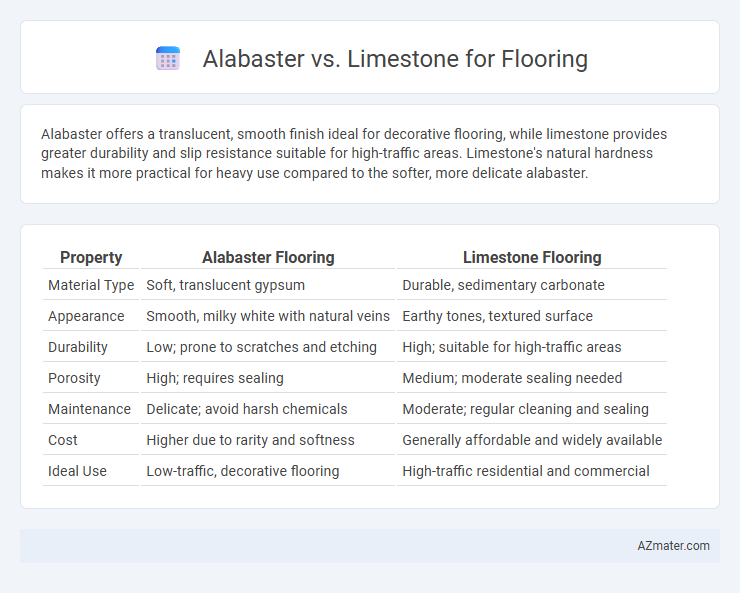Alabaster offers a translucent, smooth finish ideal for decorative flooring, while limestone provides greater durability and slip resistance suitable for high-traffic areas. Limestone's natural hardness makes it more practical for heavy use compared to the softer, more delicate alabaster.
Table of Comparison
| Property | Alabaster Flooring | Limestone Flooring |
|---|---|---|
| Material Type | Soft, translucent gypsum | Durable, sedimentary carbonate |
| Appearance | Smooth, milky white with natural veins | Earthy tones, textured surface |
| Durability | Low; prone to scratches and etching | High; suitable for high-traffic areas |
| Porosity | High; requires sealing | Medium; moderate sealing needed |
| Maintenance | Delicate; avoid harsh chemicals | Moderate; regular cleaning and sealing |
| Cost | Higher due to rarity and softness | Generally affordable and widely available |
| Ideal Use | Low-traffic, decorative flooring | High-traffic residential and commercial |
Introduction to Alabaster and Limestone Flooring
Alabaster flooring offers a unique translucent quality with its soft, creamy hues, creating an elegant and warm ambiance perfect for sophisticated interiors. Limestone flooring is renowned for its durability and natural earth tones, making it a versatile choice suited for both rustic and contemporary designs. Both materials provide distinct textures and aesthetic appeal, with alabaster favored for its smooth, polished finish and limestone prized for its rugged, matte surface.
Composition and Formation Differences
Alabaster primarily consists of the mineral gypsum, formed through the evaporation of sulfate- and calcium-rich waters in sedimentary basins, resulting in a soft, fine-grained texture. Limestone is predominantly composed of calcite (calcium carbonate), created from compacted marine organism shells, coral fragments, and sediment over millions of years, yielding a harder and more durable stone. These compositional and formation variations influence their hardness, porosity, and suitability for flooring applications.
Appearance and Aesthetic Qualities
Alabaster flooring boasts a translucent, soft, and creamy appearance with subtle veining that creates a luxurious and elegant ambiance, making it ideal for spaces requiring a refined aesthetic. Limestone, featuring earthy tones ranging from beige to gray with porous textures and natural fossils, provides a warm, rustic charm suited for traditional or casual interiors. Both materials offer unique visual qualities, but alabaster emphasizes translucence and smoothness, while limestone highlights natural texture and organic patterns.
Durability and Hardness Comparison
Alabaster, a softer mineral with a Mohs hardness of 2, is less durable and prone to scratching or damage when used for flooring, making it unsuitable for high-traffic areas. Limestone, with a higher hardness generally around 3 to 4, offers greater durability and resistance to wear, making it a more practical and long-lasting option for flooring applications. The comparative hardness and durability make limestone the preferred choice in environments requiring robust floor materials.
Porosity and Water Resistance
Alabaster exhibits lower porosity compared to limestone, making it less prone to water absorption and ideal for areas with moderate moisture exposure. Limestone's higher porosity results in greater water permeability, requiring proper sealing to prevent damage and staining. Selecting alabaster for flooring enhances durability in wet environments, while limestone demands regular maintenance to maintain its water resistance.
Maintenance and Care Requirements
Alabaster flooring requires delicate maintenance due to its softness and susceptibility to scratches and staining, necessitating gentle cleaning agents and regular sealing to preserve its appearance. Limestone flooring, being more durable and dense, tolerates routine sweeping and mopping with pH-neutral cleaners, but still benefits from periodic resealing to prevent moisture penetration and staining. Both materials demand prompt spill cleanup and avoidance of abrasive tools to maintain their aesthetic and structural integrity.
Installation Considerations
Alabaster flooring requires careful handling due to its softness and porosity, making it more prone to scratches and stains compared to limestone, which offers greater durability and resistance to wear. Installing alabaster involves using specialized sealants and gentle adhesives to prevent damage and moisture absorption, while limestone can be installed with standard mortar and grout techniques suited for heavier foot traffic. Proper subfloor preparation and moisture barriers are essential for both materials to ensure long-term stability and performance in various environments.
Cost and Affordability
Alabaster flooring tends to be more expensive than limestone due to its rarity and delicate nature, making it less affordable for large-scale projects. Limestone offers a budget-friendly alternative with its wide availability and durability, providing a cost-effective option for homeowners and builders. Pricing for limestone generally ranges from $3 to $10 per square foot, whereas alabaster can exceed $15 per square foot, significantly impacting overall flooring costs.
Best Applications and Suitability
Alabaster, known for its translucent and softer texture, is best suited for decorative indoor flooring with low foot traffic due to its susceptibility to scratching and staining. Limestone offers superior durability and is ideal for both indoor and outdoor flooring applications, especially in high-traffic areas, thanks to its hardness and natural slip resistance. Choosing between alabaster and limestone hinges on balancing aesthetic translucency against durability requirements and environmental exposure.
Environmental Impact and Sustainability
Alabaster, a softer and more delicate stone, requires less energy-intensive extraction and processing compared to limestone, reducing its overall carbon footprint. Limestone's durability and widespread availability contribute to its sustainability, yet quarrying often leads to significant habitat disruption and higher CO2 emissions. Choosing alabaster or limestone flooring involves weighing the environmental impact of sourcing and the stone's longevity to achieve eco-friendly building goals.

Infographic: Alabaster vs Limestone for Flooring
 azmater.com
azmater.com